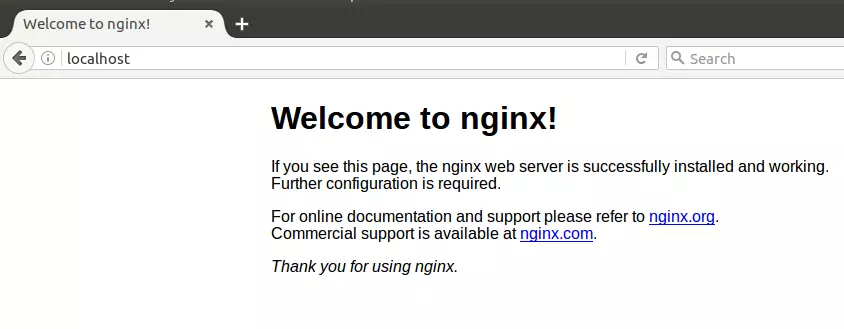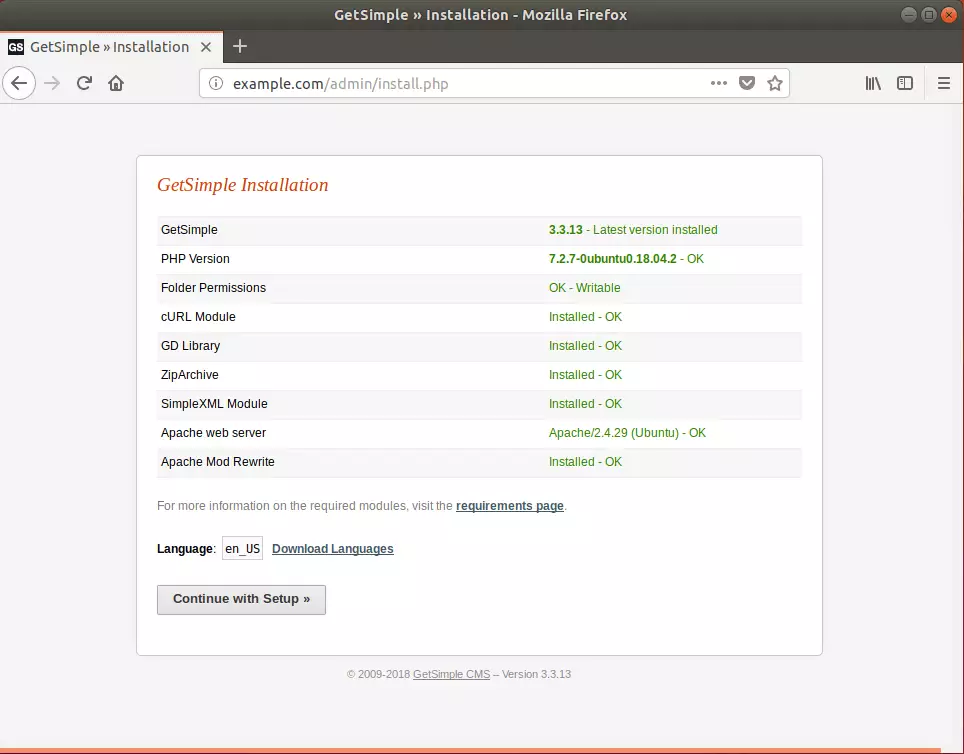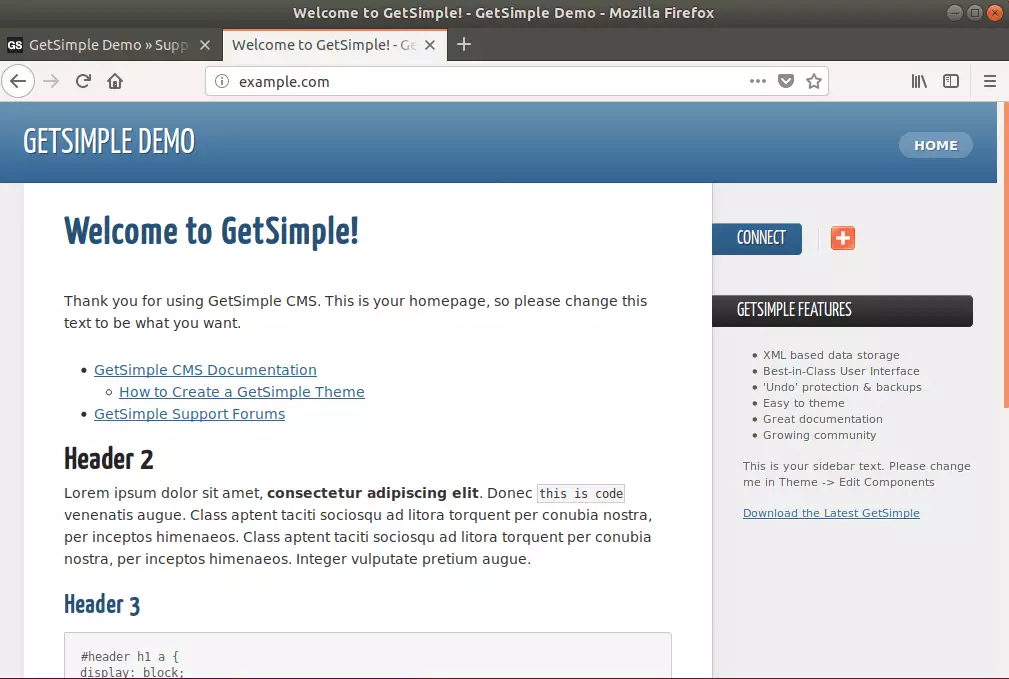This article explains installing GetSimple CMS with Nginx support on Ubuntu Linux.
GetSimple CMS is an open-source, flat-file content management system (CMS) with an easy-to-use interface for creating great websites and blogs.
Setting up GetSimple CMS with Nginx on Ubuntu Linux is a great way to create a website or blog without worrying about database management. GetSimple is a flat-file CMS that is easy to use and offers many features unavailable in PHP-based CMSs like WordPress, Joomla, or Drupal. Nginx HTTP Server is the second most popular web server, so it is a good choice to install it to run GetSimple.
This article provides step-by-step instructions on installing Nginx and PHP 7.2-FPM and related modules, downloading and setting up GetSimple CMS, and configuring Nginx to serve GetSimple content. Following these instructions lets you have a fully functional website up and running quickly and easily.
For more about GetSimple, please check out its homepage.
When you’re ready to get GetSimple working, continue with the steps below:
Install Nginx HTTP Server on Ubuntu
Nginx HTTP Server is the second most popular web server, so install it since GetSimple needs it.
To install Nginx HTTP on the Ubuntu server, run the commands below.
sudo apt update sudo apt install nginx
After installing Nginx, the commands below can be used to stop, start, and enable the Nginx service to always start up with the server boots.
sudo systemctl stop nginx.service sudo systemctl start nginx.service sudo systemctl enable nginx.service
To test the Nginx setup, open your browser and browse to the server hostname or IP address. You should see the Nginx default test page, as shown below. When you see that, then Nginx is working as expected.
http://localhost

Install PHP 7.2-FPM and Related Modules.
PHP 7.2-FPM may not be available in Ubuntu default repositories for some systems. So, you will have to get it from third-party repositories if you need it.
Run the commands below to add the below third party repository to upgrade to PHP 7.2-FPM
sudo apt-get install software-properties-common sudo add-apt-repository ppa:ondrej/php
Then update and upgrade to PHP 7.2-FPM
sudo apt update
Next, run the commands below to install PHP 7.2 and related modules.
sudo apt install php7.2-fpm php7.2-common php7.2-mbstring php7.2-xmlrpc php7.2-soap php7.2-gd php7.2-xml php7.2-cli php7.2-curl php7.2-zip
After installing PHP 7.2, run the commands below to open Nginx’s PHP default config file.
sudo nano /etc/php/7.2/nginx/php.ini
Then, save the changes on the following lines below in the file. The value below is an ideal setting to apply in your environment.
file_uploads = On allow_url_fopen = On memory_limit = 256M upload_max_filesize = 100M cgi.fix_pathinfo = 0 max_execution_time = 360 date.timezone = America/Chicago
After making the change above, please save the file and close it.
After installing PHP and related modules, you must restart Nginx to reload PHP configurations.
To restart Nginx, run the commands below
sudo systemctl restart nginx.service
Download GetSimple Latest Release
Next, visit the GetSimple site and download the latest package. Or run the commands below to download GetSimplepckages.
After downloading, run the commands below to extract the downloaded file and move it into a new GetSimple CMS root directory.
cd /tmp && wget http://get-simple.info/data/uploads/releases/GetSimpleCMS-3.3.13.zip sudo mkdir /var/www/html/getsimple sudo unzip GetSimpleCMS-3.3.13.zip -d /var/www/html/getsimple
Then, run the commands below to set the correct permissions for GetSimple to function correctly.
sudo chown -R www-data:www-data /var/www/html/getsimple/ sudo chmod -R 755 /var/www/html/getsimple/
Configure Nginx GetSimple Site
Finally, configure the Nginx configuration file for GetSimple. This file will control how users access GetSimple content. Run the commands below to create a new configuration file called get simple.
sudo nano /etc/nginx/sites-available/getsimple
Then copy and paste the content below into the file and save it. Replace the highlighted line with your domain name and directory root location.
server {
listen 80;
listen [::]:80;
root /var/www/html/getsimple;
index index.php index.html index.htm;
server_name example.com www.example.com;
client_max_body_size 100M;
location / {
try_files $uri $uri/ /index.php?id=$uri&$args;
}
location ~* /admin/.*\.php$ {
try_files $uri /admin/index.php?id=$uri&$args;
fastcgi_index index.php;
}
location ~ \.php$ {
include snippets/fastcgi-php.conf;
fastcgi_pass unix:/var/run/php/php7.2-fpm.sock;
fastcgi_param SCRIPT_FILENAME $document_root$fastcgi_script_name;
}
}
Save the file and exit.
After configuring the VirtualHost above, please enable it by running the commands below.
Enable the GetSimple Site
After configuring the Virtual Host above, please enable it by running the commands below, then restart the Nginx server.
sudo ln -s /etc/nginx/sites-available/getsimple /etc/nginx/sites-enabled/ sudo systemctl restart nginx.service
Restart Nginx
sudo systemctl restart nginx.service
Next, open your browser and browse to the server hostname or IP address. You should see the GetSimple page.
http://example.com/admin

Create the site name and admin account. Click Install Now!

That’s it!

Enjoy!
You may also like the post below:

Leave a Reply